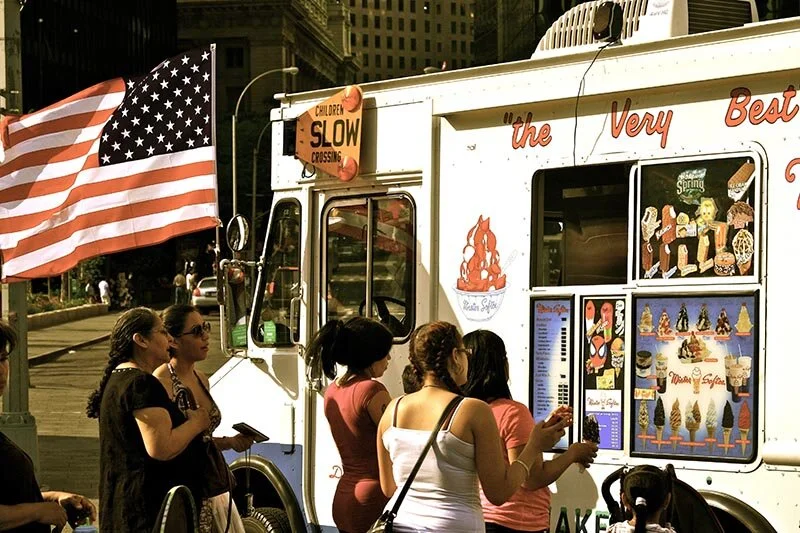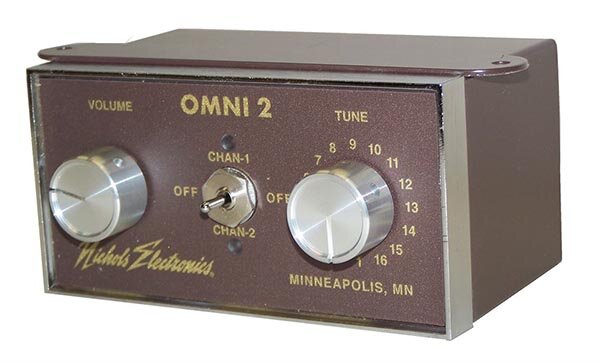The Infectious & Sometimes Annoying Appeal of Ice Cream Truck Music
The soundtrack to your childhood does more than just sell cones and popsicles.
By Jessie Schiewe
Photo: Wikimedia / Alex Proimos
You know it’s coming before you see it thanks to the ice cream truck’s pervasive, niggling, and occasionally blaring music.
The songs differ from truck to truck, brand to brand, vendor to vendor, but they all have the same high-pitched, tinny qualities that can somehow make an ice cream truck half-a-mile away sound like it’s right in front of you.
For some, ice cream truck music can be nostalgic, reminding one of childhoods spent playing in the park.
For others, it can have an almost pavlovian appeal, enticing one to hand over whatever cash they have to buy a Creamsicle or a Choco-Taco, despite dieting or having just eaten.
A harbinger of warm weather, ice cream truck music is also an unofficial indicator that winter is over and that summer, with all of its indulgences and freedoms, is right around the corner.
In some ways, ice cream trucks were the predecessors to modern-day food trucks, replacing sweet, melty confections with actual cooked, fried, and sautéed vittles. Instead of filling their small spaces with freezers, food trucks introduced built-in kitchens and ditched the tell-tale ditties ice cream trucks use to announce their presence. There are undoubtedly many people who are grateful for that last omission in food trucks’ designs.
Before ice cream truck music became as ubiquitous as it is now, it was seen as a novel approach to improving ice cream sales, with many early vendors using the chiming of bells to lure hungry children curbside.
According to Daniel Neely, an ethnomusicologist and author of the book Soft Serve: Charting the Aural Promise of Ice Cream Truck Music, actual tunes weren’t introduced to the business until 1929 when an ice cream vendor in California strapped an amplified music box to the roof of his truck. He chose a Polish folk song called “The Farm Pump” to blare on repeat.
It worked like a charm, marking the beginning of a long and annoying tradition of playing loud, old-fashioned songs that are generally not protected by copyright to woo children outdoors.
Photo: Flickr/Jose Miletti
Today, ice cream truck vendors play a medley of music when peddling their goods, and some songs are more popular than others.
In Spokane, Washington, you’re likely to hear trucks playing “It’s a Small World,” while those in the New York area get to enjoy the custom melody composed specifically for Mister Softee vendors.
Among the most recognizable and oft-used musical options for ice cream trucks is “The Entertainer,” a ragtime piano tune created by the black composer Scott Joplin in 1902.
Another popular ice cream truck song that is recognizable to any adult who spent time frequenting confectionaries-on-wheels is also surprisingly racist. Called “N****r Love a Watermelon Ha! Ha! Ha!,” it was released in March 1916 by Columbia Records, and was probably able to make its way onto so many ice cream trucks’ speakers simply because the lyrics were never included.
Most ice cream truck music plays on 40-seconds loops and has just as strong an affect, if not stronger, on the people manning the truck. It is not uncommon for ice cream truck vendors to hear the tunes they listen to on the job playing in their heads at night when they sleep.
The music itself usually comes from a device called a music box that can be found in most ice cream truck models.
The Omni 2 Music Box from Nichols Electronics which can play up to 32 songs. (Nichols Electronics)
One of the most well-known music box companies is Nichols Electronics, a manufacturer in Minneapolis, Minnesota, that has been helping ice cream trucks attract customers since 1957. Its electronic music boxes, which run between $185 and $225, can be custom programed to play one’s own songs or can come pre-stocked with options from Nichols’ library of tunes that are recorded either digitally or in the mechanical “old-style.” In addition to “The Entertainer,” their offerings include plenty of instantly recognizable tunes, including “La Cucaracha,” “Camptown Races,” “Pop Goes the Weasel,” “Twinkle, Twinkle,” and “I’m a Little Teapot.”
The perks of playing music are plenty when you’re an ice cream truck vendor. As Nichols Electronics notes on its website, “Ice cream vending is a very competitive business. You need to be heard above the background noise whether it be an urban setting or the country.”
Photo: Wikimedia / Scott Long
But ice cream truck music does more than help sell cones and SpongeBob SquarePants popsicle bars (reportedly one of the best-selling offerings on many ice cream truck menus). Their music has also been used to prevent riots and fight crime.
Ice cream truck music — and ice cream trucks in general — have also been used for more nefarious reasons.
Criminals have played ice cream truck music in attempts to abduct unwitting children, and there is a long and storied tradition of selling drugs out of the roving vehicles. Recently, in New York City, pranksters automated newly installed public Wi-Fi booths to play the instantly recognizable music on-repeat to the annoyance of many.
Because let’s be honest, ice cream truck music is annoying. Noise complaints against them are not uncommon, and have been happening since at least the 1990s. From 2010 to 2014, New Yorkers lodged more than 7,000 complaints against the irksome jingles, or about five complaints per day. Journalists have even penned angry op-eds against them.
Photo: Flickr / Javier Rapoport
Of course, efforts have been made to minimize the noise of ice cream trucks. In some cities, ice cream trucks have curfews for when they must stop playing their music. There are also rules preventing ice cream trucks from playing their music while parked. But these requirements differ by location and aren’t exactly top priorities for law enforcement to enforce.
With the approach of summer, you’re likely to start hearing the tell-tale jingles of ice cream trucks sometime in the near future. And how you respond to them will probably have a lot to do with your age. If you’re too old to treat yourself to a spur-of-the-moment Neapolitan ice cream sandwich in the middle of a work day, then you’re probably too old to appreciate the soundtrack that comes with it.





















